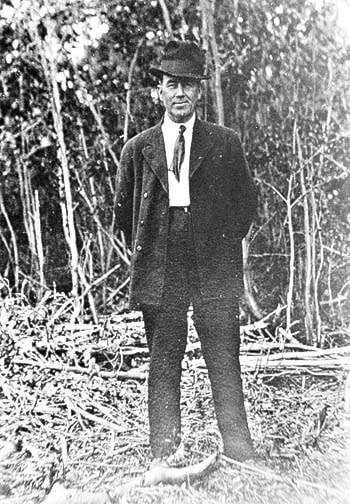Back in the early 1900s the main way to get between Whitehorse and Dawson by land was to hop a coach or a sleigh on the Overland Trail.
And back then “Hobo Bill” Donnenworth was one of the route’s most famous drivers.
Many travellers would wait in Whitehorse or Dawson for days in order to ride the six-day rough and dangerous trip with Hobo Bill.
Before becoming a famous coach driver, Donnenworth had many adventures in the North.
Like many other famous names in Yukon history, Donnenworth followed the lure of gold to the Klondike in 1897.
“I wanted adventure,” he told a biographer for the Vancouver Province in June 1944. “My age was 23. Life and romance was ahead of me. I found these in the Yukon—but little gold.”
When Donnenworth first arrived in Skagway he worked on a 20-horse pack train that hauled freight to the top of the White Pass summit.
Each horse carried 150 pounds, and each pound of freight cost its owner one dollar to pack.
“The trail was a fighting mass of horses, sleighs, men and dogs,” said Donnenworth. “The drivers, packers and mushers got in each other’s way. They fought and screamed for room. All had one thought—gold. It was everybody for himself.”
Donnenworth followed the stampede in Atlin but by the time he and his mates arrived in the town all of the land had been staked. So they moved on to Spruce Creek.
“We built sluice and riffle boxes. Then stood in the freezing swirling water for long days digging gravel, throwing it into the boxes and always hoping that the next shovelful would bring the gleaming metal.”
They found just two pocketfuls of gold over the next few months and Donnenworth was on his way again, this time to haul freight for the White Pass and Yukon Route railway, which was being built.
Soon after the stagecoaches began to run between Whitehorse and Dawson, and Donnenworth took a job as a driver.
Part of Donnenworth’s job was to transport gold between Dawson and the banks at White Horse.
“The gold would be conveyed in boxes weighing 500 pounds. A pound of gold would be worth $196, so you can imagine the valuable cargo I carried sometimes if I had many boxes,” Donnenworth told the Province on May 20, 1928.
Though he carried a lot of precious freight, Donnenworth did not worry about getting robbed.
“When I slept at the roadhouse overnight I just left the gold out in the stagecoach,” said Donnenworth. “The boxes were too heavy to lift.”
Between 1902 and 1921 Donnenworth and his wife lived at 3126 Third Avenue in Whitehorse, a small blue home now known as the Donnenworth House. `
Built between 1900 and 1904, this house was originally a small frame building with a tent attached to the rear.
From 1902 to 1945, the Donnenworth House was owned by the British Yukon Land Company, a subsidiary of White Pass & Yukon Route, the major employer in Whitehorse until the Second World War.
It was one of their oldest Whitehorse staff houses and was rented to various tenants.
Today the house, which now houses the Yukon Historical and Museums Association, is distinctive because it is one of the last Whitehorse buildings retaining its original canvas and frame materials.
This column is provided by the MacBride Museum of Yukon History. Each week it will explore a different morsel of Yukon’s modern history. For more information, or to comment on anything in this column e-mail lchalykoff@macbridemuseum.com.
